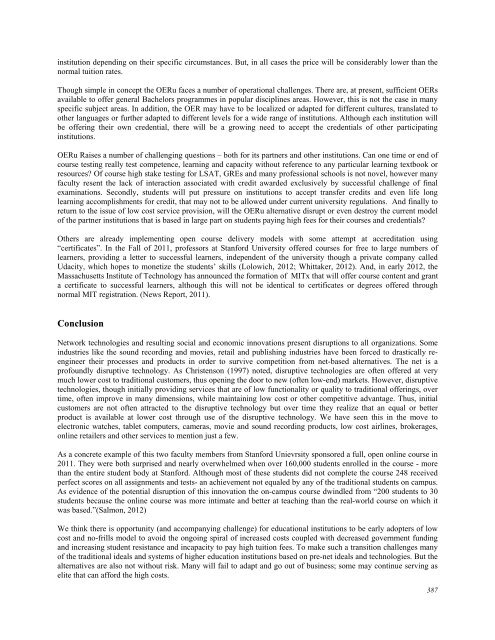October 2012 Volume 15 Number 4 - Educational Technology ...
October 2012 Volume 15 Number 4 - Educational Technology ...
October 2012 Volume 15 Number 4 - Educational Technology ...
Create successful ePaper yourself
Turn your PDF publications into a flip-book with our unique Google optimized e-Paper software.
institution depending on their specific circumstances. But, in all cases the price will be considerably lower than the<br />
normal tuition rates.<br />
Though simple in concept the OERu faces a number of operational challenges. There are, at present, sufficient OERs<br />
available to offer general Bachelors programmes in popular disciplines areas. However, this is not the case in many<br />
specific subject areas. In addition, the OER may have to be localized or adapted for different cultures, translated to<br />
other languages or further adapted to different levels for a wide range of institutions. Although each institution will<br />
be offering their own credential, there will be a growing need to accept the credentials of other participating<br />
institutions.<br />
OERu Raises a number of challenging questions – both for its partners and other institutions. Can one time or end of<br />
course testing really test competence, learning and capacity without reference to any particular learning textbook or<br />
resources? Of course high stake testing for LSAT, GREs and many professional schools is not novel, however many<br />
faculty resent the lack of interaction associated with credit awarded exclusively by successful challenge of final<br />
examinations. Secondly, students will put pressure on institutions to accept transfer credits and even life long<br />
learning accomplishments for credit, that may not to be allowed under current university regulations. And finally to<br />
return to the issue of low cost service provision, will the OERu alternative disrupt or even destroy the current model<br />
of the partner institutions that is based in large part on students paying high fees for their courses and credentials?<br />
Others are already implementing open course delivery models with some attempt at accreditation using<br />
“certificates”. In the Fall of 2011, professors at Stanford University offered courses for free to large numbers of<br />
learners, providing a letter to successful learners, independent of the university though a private company called<br />
Udacity, which hopes to monetize the students’ skills (Lolowich, <strong>2012</strong>; Whittaker, <strong>2012</strong>). And, in early <strong>2012</strong>, the<br />
Massachusetts Institute of <strong>Technology</strong> has announced the formation of MITx that will offer course content and grant<br />
a certificate to successful learners, although this will not be identical to certificates or degrees offered through<br />
normal MIT registration. (News Report, 2011).<br />
Conclusion<br />
Network technologies and resulting social and economic innovations present disruptions to all organizations. Some<br />
industries like the sound recording and movies, retail and publishing industries have been forced to drastically reengineer<br />
their processes and products in order to survive competition from net-based alternatives. The net is a<br />
profoundly disruptive technology. As Christenson (1997) noted, disruptive technologies are often offered at very<br />
much lower cost to traditional customers, thus opening the door to new (often low-end) markets. However, disruptive<br />
technologies, though initially providing services that are of low functionality or quality to traditional offerings, over<br />
time, often improve in many dimensions, while maintaining low cost or other competitive advantage. Thus, initial<br />
customers are not often attracted to the disruptive technology but over time they realize that an equal or better<br />
product is available at lower cost through use of the disruptive technology. We have seen this in the move to<br />
electronic watches, tablet computers, cameras, movie and sound recording products, low cost airlines, brokerages,<br />
online retailers and other services to mention just a few.<br />
As a concrete example of this two faculty members from Stanford Unievrsity sponsored a full, open online course in<br />
2011. They were both surprised and nearly overwhelmed when over 160,000 students enrolled in the course - more<br />
than the entire student body at Stanford. Although most of these students did not complete the course 248 received<br />
perfect scores on all assignments and tests- an achievement not equaled by any of the traditional students on campus.<br />
As evidence of the potential disruption of this innovation the on-campus course dwindled from “200 students to 30<br />
students because the online course was more intimate and better at teaching than the real-world course on which it<br />
was based.”(Salmon, <strong>2012</strong>)<br />
We think there is opportunity (and accompanying challenge) for educational institutions to be early adopters of low<br />
cost and no-frills model to avoid the ongoing spiral of increased costs coupled with decreased government funding<br />
and increasing student resistance and incapacity to pay high tuition fees. To make such a transition challenges many<br />
of the traditional ideals and systems of higher education institutions based on pre-net ideals and technologies. But the<br />
alternatives are also not without risk. Many will fail to adapt and go out of business; some may continue serving as<br />
elite that can afford the high costs.<br />
387

















